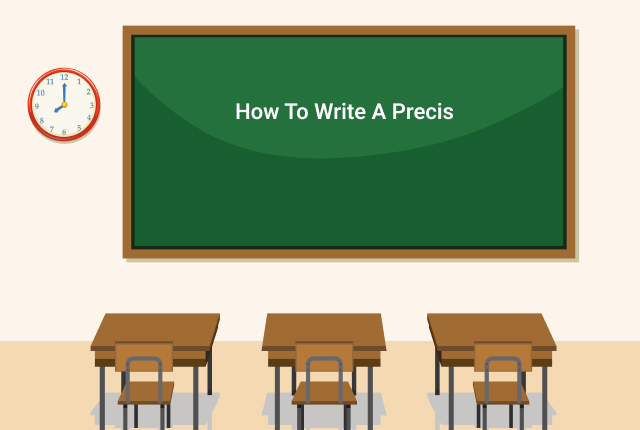
To summarize a long play, you would focus on the important events or highlights before wrapping it up. Precis writing is exactly that. The relevance of Precis writing stems from the fact that it is a smaller portrait of the main passage that maintains the original passage’s mood and tone. Let’s look at the specifics of Precis writing.
You are definitely going to focus on the meaningful events or say highlights from a play you have watched when you share its plot with a friend. Right? Well, this is exactly what Precis writing is about. To put it in perspective, Precis writing is a crisper, precise and succinct version of the main passage. Reducing it to summarize into a precis does not mean taking away its essence but maintaining the passage’s original tone, style and overall vibe.
Let’s delve into the specifics.
Table of Contents
What is meant by Precis Writing?
Precis writing refers to compressing a long, detailed passage into a few words. However, precis must and should contain all the key details, such as facts and figures mentioned in the original passage so that regardless of who reads, he or she gets to have an overview of the main concept of the passage. It is pertinent to note that to be able to convey the exact meaning in just a few words can be one challenging task. Therefore, it is important for the Precis writer to thoroughly read the text and understand it before attempting to derive a precis out of it.
Now that you know what Precis is, let’s shed some light on its uses.
Uses of the Precis Writing
In today’s era of technological advancements, the attention span has greatly reduced. While the consumption of information remains constant, the style of consumption has reduced. People are now consuming information on the go and like everything short and crisp. Precis solves this problem as its focus is to communicate the most important details to its readers without altering the theme, style, or tone of the article.
Speaking of the use of precis writing, it is essential and of great use when it comes to scientific reports and research. Since they are lengthy in nature, it is often required to break them down into smaller passages encompassing the most important details so as to convey the crux of their contents. Other than this, it can be used to talk about a movie. Again, movies are spread across at least 2 hours, so precis writing here can be used to compress it and convey the important parts and twists of the movie. Similarly, precis writing is a very popular mode of communication in the corporate world. Companies and businesses use it for job descriptions, reports, and meeting highlights in addition to hundreds of other uses. On the other hand, precis writing is great for students who are swamped with lectures and are looking for a shorter way to understand the core concepts in a chapter.
Why are students given to write Precis?
Students are assigned to write precis for a number of reasons. It is regarded as the most effective form of academic assignment by professors. To begin with, it allows them to see how well students can think critically and summarize accordingly. It also gives them a perspective on students’ abilities as to how well they are able to detect the important information from the excerpt. Not only this, but precis writing as an assignment also demonstrates the writing skills of the students; how well they are able to express and articulate their thoughts in a clear manner. Finally, composing a precis is considered an effective and efficient way to learn and understand new materials and concepts.
Precis writing format
Now that we have the basics, let’s look deeper into this form of writing. And to do so, we will first touch upon its format and layout.
When writing a precis, whether a rhetorical or regular one, make sure that your paper has these 5 key qualities:
It does not matter when you are writing a regular precis or a rhetorical one, make sure that your precis encompasses the five key qualities. They should be:
- Concise
- Objective
- Coherent
- Clear/clarity
- Correct/Accurate
Concise
Unless it is a requirement for you to meet a certain word count bracket, make sure to keep your precis to 1/4th size of the original work. This is what being concise means. Therefore, make sure there are no redundancies, wordiness, fluffs or unnecessary details.
Objective
In a precis, it is imperative that it provides an objective construction of the important information mentioned in the original piece, without incorporating any of those personal opinions of yours.
Coherent
By coherency, it means that whatever you write should make sense. Avoid just throwing bits of pieces of information here and there. Make sure there is a proper layout and that everything written is in a nice, sequential and logical order.
Clear/clarity
The whole idea of precis is to ensure that the reader connects with it, and understands the original writing and the ideas without having to go through it. To sum up, it should be a breeze to read it. Hence, make sure the use of language is simple and the sentence structures are proper.
Correct/accurate
It is of prime importance that everything mentioned and included in the precise is factually and figuratively correct. In addition to this, all the elements of the writing, grammar, spelling and punctuation should be accurate. This not only makes the piece accurate but also engaging, persuasive and easy to read.
What should be the style to use in precis writing?
- Precis Title: Précis of [Author’s Name]’s “[Name of Work/Article]”
- Font Size: 12 point
- Spacing: Double
- Margins: At least 1 inch from all sides
- Name and Pledge: Place them at the end of your precis
- Tone: Stay close to the author’s voice in the original writing
- Direct Quotations: Put quotes in quotation marks and include a page number in parentheses
- Sequence: Stick to the order of the original piece
Types of Precis Writing
When talking about types, then there are four to precis writing:
Precis of Speech: This is the type where you retain the original idea but use your own style and tone to summarize the passage.
Precis of Continuous Matter: Each and every kind of matter falls under the umbrella of continuous matter. This, however, does not include communication.Question/Answer forms, parliamentary and evidence reports are all examples of this type of writing.
Precis of Correspondence: The two types of Precis correspondence are Index Precis and Narrative Precis. The index precis is provided as a table, whereas the narrative precis is descriptive.
Under this type are subtypes, namely, Index Precis and Narrative Precis. Speaking of index precis, they are provided in the form of a table. As for narrative precis, they are written in a descriptive form.
Telegraphese: Formulated in a telegram style, this type of precis summary makes use of fewer words and while doing so, makes sure that the passage’s original idea, meaning and message remain intact.
How to write a precis?
So, are you wondering about how to write one? Well, here is a comprehensive, step-by-step guide to help you write a compelling precis. Let’s get started without any further delay, folks!
Step 1: Pick a piece; an article or story you want to write a precis on
Unless you were assigned to write your precis on some specific material, you will have to choose the original piece yourself. In this case, be sure to choose an article or work that is publicly available in its full length, so that you can read the whole thing.
Unless assigned, you will have to choose the piece on your own to get started. Should this be the case, it is recommended to choose a piece of work that is available publicly, that too in its full length. Because obviously, you would need the entire piece to be able to craft an engaging precis!
Step 2: Read the original work thoroughly
Do not rush at all and take your time to go through the piece in its entirety. It is important that you read the piece carefully to make sure that you have a sound understanding of it. This will ensure that you write a precis that is clear, concise and clear.
Step 3: Re-read it and jot down notes
It is suggested to go through it again after the first read. This is because the first time you read it, it gives you a grasp of its general idea. Going through it again will give you a fresher perspective and from then on you will be able to interpret the core ideas discussed by the author. And, yes, don’t forget to take notes!
Step 4: Construct an outline
List out all the key details you managed to find out based on your notes. This will give you a birds-eye view of whether or not everything important is covered. Once done, move on to making a clear outline to form your precis on.
Step 5: Start writing a precis
Now is the time to start working on your precis! Make sure to follow the guidelines given by your professor in addition to your outline. As mentioned earlier, make it a point to use simple language, and easy-to-read sentence structures and keep a firm eye on the precis’s size.
Step 6: Proofread and edit
This is the final phase where you run a thorough check on everything. Make sure to see that all the important details are included in your text. Additionally, make sure there are no unnecessary details. Once this is sorted, look out for any mistakes in your draft in terms of grammar, punctuation and spelling. Polish it until you are satisfied with its overall look and feel!
Things to avoid
In precis writing, it is crucial to avoid the use of abbreviations, throwing questions in the synopsis, and including one’s own opinions or point of views. Avoid making it too long and using jargon-y language.
As for the writing style while writing a precis, make sure it is formal in nature with absolutely no grammatical, spelling or punctuation errors. It should be to the point and easy to read. The use of simple language should be consistent throughout the piece.
And this is it! We hope this article helps you in becoming an amazing precis writer. If you have carefully read it and followed the above-mentioned step, we are sure you will be able to write a very gripping precis piece, that too with utmost ease.








